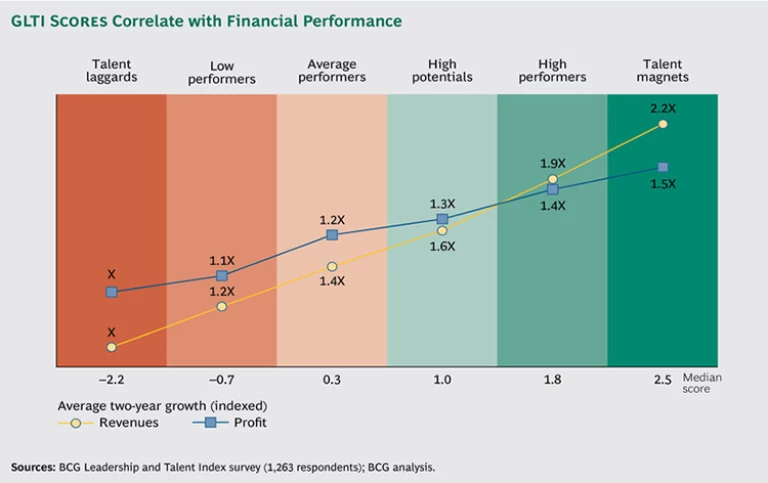In May, BCG’s Matthias Tauber and Martin Feth wrote about mining companies’ need to pursue commercial excellence and maximize asset productivity to achieve and sustain a competitive advantage. BCG’s recent Global Leadership and Talent Index (GLTI) draws attention to a third source of advantage: leadership.
The GLTI shows that companies that invest in leadership development (we call them “talent magnets”) grow their revenues 2.2 times faster and their profits 1.5 times faster than companies that neglect this imperative (“talent laggards”). (See the exhibit “GLTI Scores Correlate with Financial Performance.”)
These insights have major implications for the mining industry. While cost pressures are forcing companies to concentrate on operational excellence and technological innovation, they can’t afford to ignore the people side of the financial-performance equation.
Yet a recent BCG benchmarking study found that many companies focus their leadership development efforts on executives and “rising stars,” suggesting insufficient attention to the front line. In mining, neglecting frontline leaders—haul truck supervisors, maintenance shift leaders, engineering graduate managers, drill and blast bosses—can be a big mistake. In this industry (as in many others today), productivity gains and agility in the face of constant change are critical for performance. What’s more, mining is strongly characterized by dispersed work teams operating across multiple locations and often speaking an array of languages. To survive (never mind thrive) in this environment, companies need frontline leaders who can solve problems with their teams (rather than pass them on to the next shift or downstream). Leaders also need to know how to foster collaboration across teams at key interface points (such as loading and hauling in a pit).
Developing such leaders takes hard work. But we don’t expect mining companies to shy away from the effort. After all, they’ve already built a strong safety culture, proving they have the mettle to do what’s needed—no matter how challenging.
Drawing on BCG’s work in multiple industries, we developed a four-step approach that mining companies can use to build the right capabilities in their frontline leaders. Below, we examine each step.
Step 1: Define Leadership Capabilities Needed to Execute Your Strategy
What does your competitive strategy emphasize? Is it operational excellence? Product or service innovation? What leadership capabilities will most enable your frontline teams to help execute your strategy? Consider “hard” capabilities, such as unit-level strategy development, change leadership, and risk management, along with “soft” capabilities such as personal adaptability, time management, and communication. For each capability you’ve listed, identify the knowledge, skills, and attitudes frontline leaders need to master that capability. For instance, if you’ve identified people development as a key capability, your leaders will need knowledge about how to create developmental opportunities for their teams, skills in providing guidance, and a caring attitude toward their people.
Step 2: Teach People the Way Adults Learn
In organizations, adults learn best through on-the-job experiences. So frame teaching around recognizable daily activities to make learning practical and relevant for frontline leaders. For instance, in all your selected teaching methods (written materials, workshops, online learning), explain how frontline leaders can use the knowledge, skills, and attitudes they’re learning about in their morning meetings, shift handovers, and one-on-one conversations with team members and peers.
Step 3: Build a Cohesive Development Program
Ensure that the teaching tools and methods you’re using reinforce each other. For instance, use written materials, videos, and automated reminders to boost awareness of the knowledge, skills, and attitudes frontline leaders need to master. Use work sessions, leader-led discussions, and best-practice sharing to help them build their capabilities. And make regular use of online learning and assessment tools to reinforce their new learning day to day.
Step 4: Make It Stick
Encourage frontline leaders to have ongoing feedback discussions with their direct reports, peers, and managers to gain insights into their effectiveness. Simple tools, including 360-degree feedback surveys, can help leaders solicit and document such feedback. Help leaders use the feedback to identify their strengths and areas for development in the capabilities you’ve identified as critical for executing your strategy. Aggregate feedback from your multiple businesses and functions to identify actions needed to support continuous improvement in frontline leaders’ capabilities, such as workshops on specific skills or refinement of teaching tools. Demonstrate the impact of your program, by measuring and reporting leaders’ performance on critical capabilities alongside other key indicators, such as costs, revenues, and safety.
Building frontline leaders’ capabilities can help mining companies boost their productivity, providing a solid rationale for investments in leadership development programs. The process we describe here can help. Mining companies that combine investment in people with commercial excellence and maximized asset productivity will prove tough acts to beat in this increasingly challenging industry. This article was first published in Mining Journal on August 29, 2015.








